Osteochondrosis is considered one of the most common diseases today, often affecting women over the age of 25. The disease is characterized by an acute, rapid course, especially when comparing the course of the disease in male patients.
The pathological processes that accompany the disease are the destruction of joint tissues, intervertebral discs. Pathology is the cause of headaches in 30% of cases. If women develop symptoms of cervical osteochondrosis, you should seek medical attention immediately, this will help to avoid further development of the disease.

What is cervical osteochondrosis
Osteochondrosis is a chronic disease, accompanied by damage to one or more parts of the spine. Depending on this, the clinical manifestations of the disease vary.
The main load falls on the lower back, but with the defeat of the cervical region, there are many more problems. This is due to the anatomical characteristics of the body, in the cervical region there are many fibers and nerve endings, there are also vessels on which blood circulation in the brain depends.
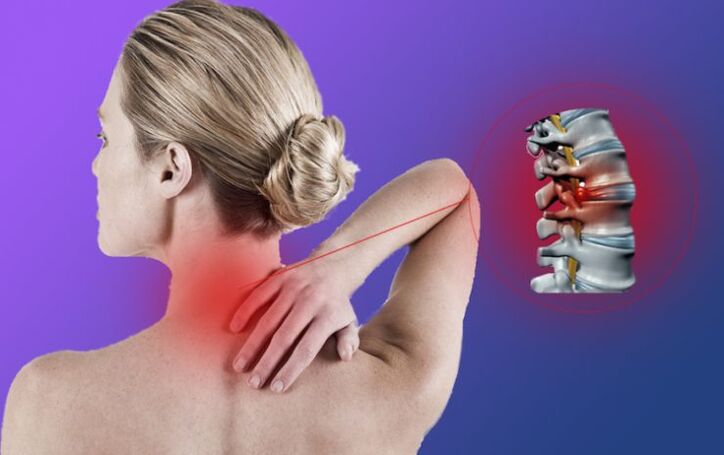
The cervical region is considered more vulnerable due to the proximity of the vertebrae and their proximity to the arteries involved in delivering nutrients to the brain. The movement of the vertebrae leads to compression of the nerve roots and arteries, after which changes occur in the intervertebral cartilage, hernias and protrusions develop. These changes in the intervertebral discs often have an age-related character, and the disease can manifest itself at a young age.
Predisposing factors
There are a number of reasons for the development of cervical osteochondrosis in women, and predisposing factors include the following:
- taking hormonal drugs - this leads to metabolic disorders;
- increased load on the spine and spinal muscles (develops as a result of improperly organized workplace, when working in hazardous industries or weightlifting, professional sports);
- violation of diet, use of unhealthy foods, lack of nutrients;
- insufficient water intake (clean, without harmful additives and impurities) - this leads to drying of cartilage tissues, ligaments, which leads to clogging of the body with toxins;
- low physical activity - in the background of lack of physical exercise, there is a violation of blood circulation in the muscles, insufficient nutrition of the intervertebral discs;
- genetic predisposition, congenital curvature of the spine;
- previous diseases (arthritis, arthrosis, neuralgia, vasospasm, etc. );
- transmitted spinal injuries;
- constant stress - often psychosomatic in nature, on the background of tension there is an uncontrolled contraction of muscles, as a result, the processes of blood circulation are slowed down, the flow of lymph fluid, deposits of toxins and toxins are observed.

Secondary risk factors:
- incorrect position of the spine during sleep and rest, wrong choice of mattresses and pillows;
- sleeping without a pillow;
- pregnancy;
- overweight.
Age - as the body ages, wear and tear of the vertebrae, wear of cartilage tissue, leaching of calcium, improper distribution of body weight on the feet, uneven load on the spine.
Symptoms of cervical chondrosis in women
Cervical osteochondrosis can be asymptomatic for a long time, many attribute the limitation of motor activity to fatigue, and pain in the initial stages of the disease is often absent.

The appearance of pain is often associated with poor sleep, frequent stress. In some cases, the signs of ordinary cervical osteochondrosis in women appear fairly quickly. One day ago the woman could feel well, and the next day her severe pain did not allow her to move freely, until she was unable to lift her head from the pillow. This condition is a reason to seek medical help, at this stage you can easily cope with the signs of the disease.
General symptoms of the disease
The symptoms of the acute stage of cervical osteochondrosis in women are more pronounced. Cartilage puts pressure on nerve roots, puts pressure on arteries that run along the spine. There is a danger of short-term memory loss, due to oxygen starvation, frequent fainting occurs. Lack of therapy in the presence of pain, numbness in the shoulder area, tingling in the fingers and other symptoms can lead to paralysis.

Reflex syndrome
Manifestations of cervical osteochondrosis in women are often associated with reflex syndromes, the symptoms of which occur against the background of constant irritation of spinal cord receptors, due to which neurons are reflexively excited.
This leads to malnutrition, metabolic processes, and at the same time blood vessels and nerves are compressed.
Reflex syndromes are divided into:
- Painful - back pain, neck pain, neck pain, simultaneous pain in the neck, shoulder / forearm.
- Muscle tonic - constant muscle tension, which results in starvation with oxygen, swelling, seals.
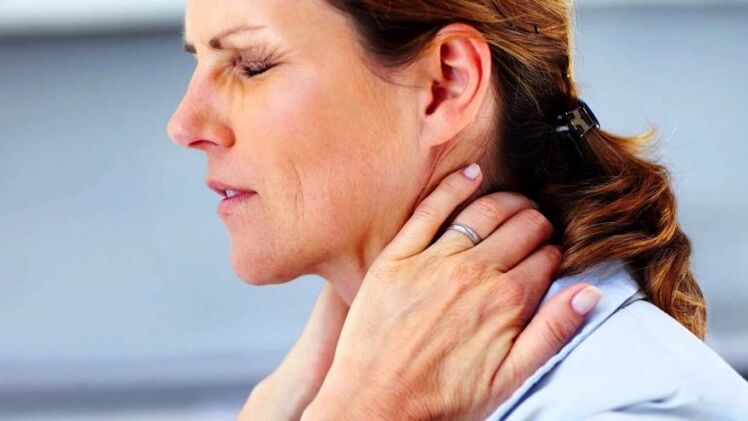
Occasionally there may be cramps in the muscles of the head, cervical region and shoulder girdle.
In the initial phase of the development of the disease, syndromes of the lower oblique muscle of the head, scapular-costal syndrome, vertebral artery syndrome, and tension of the scapular muscle often occur.
radicular syndrome
In osteochondrosis of the cervical spine, radicular syndrome often occurs in women, which is accompanied by compression of the vessels of the nerve roots of the spinal cord. The pathology is accompanied by movement disorders in the hands, loss of sensitivity. In this case, there are disorders of internal organs (pathology of urination, sexual dysfunction, hypertension, memory impairment). Injury to blood vessels can occur unexpectedly, with sudden movements in the affected area.
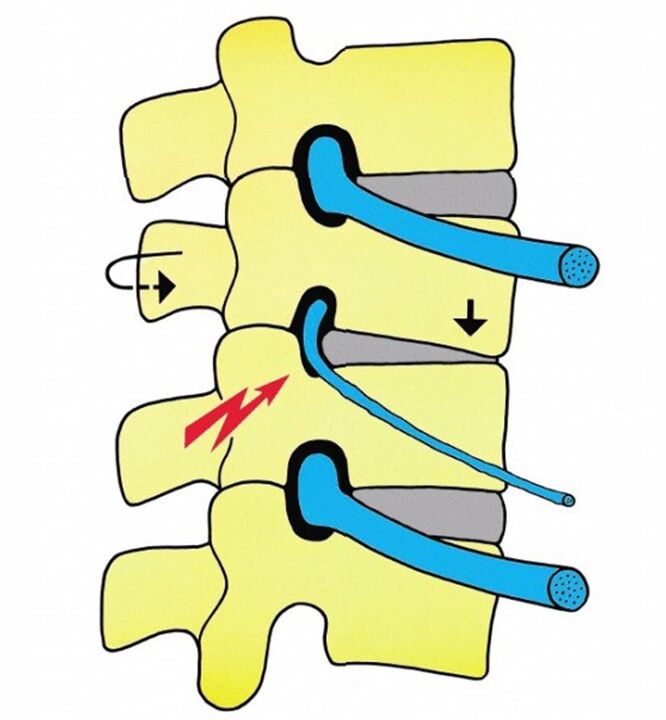
Vascular syndrome
In the background of the symptoms of spinal cord compression, in women there is a symptom of osteochondrosis of the cervical spine, in extreme cases an ischemic stroke develops. This complication is accompanied by a violation of motor activity of the limbs, decreased sensitivity, deterioration of internal organs. Sometimes the organs stop functioning, and if the kidneys fail, there is a high probability of death.

Stages of development of osteochondrosis
There are four stages of the disease, all of which are accompanied by certain pathological changes.
1 phase
In the first phase of the disease development, damage to the pulpal nucleus of the intervertebral disc is observed. This phenomenon occurs against the background of violations of metabolic processes in the body, as a result of dehydration, the nucleus dries out, decreases in size and becomes less durable. The spine becomes more sensitive to physical stress, there is no pain syndrome at this stage. Diagnosis at this stage does not require medication.
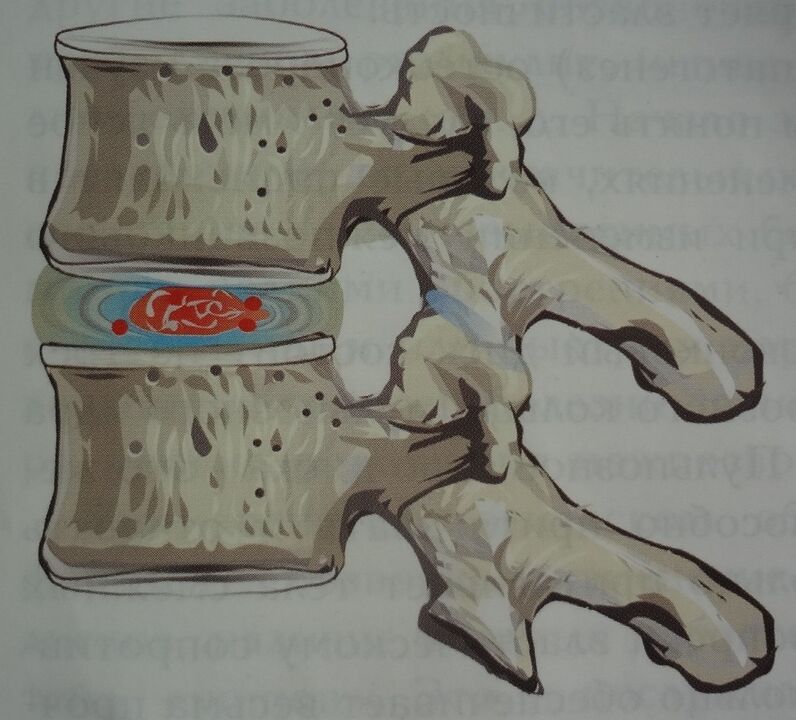
2nd stage
At this stage, the fibrous ring is damaged, cracks and fissures appear on the surface of the intervertebral disc due to the load on the spine. The ring becomes thinner, the nucleus moves into tears and cracks, which leads to their spread. The enlarged disc protrudes beyond the vertebrae, the disc protrudes, and the process is accompanied by pain.
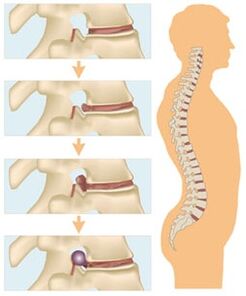
3rd stage
In third-degree osteochondrosis, an intervertebral hernia is formed, and the fibrous ring is torn. The nucleus pulposus moves into the subglottic cavity, resulting in disc herniation. The pathological process leads to damage to nearby vascular, muscle tissues, ligaments and nerves.
4 stage
This phase is accompanied by degenerative restoration of the spinal column, its duration reaches 12 months. During this period there is a change in the nature of bone growth, they begin to grow in width, which leads to an increase in the area of the vertebrae. This leads to the formation of osteophytes, which reduces the mobility of the spine, stops destructive processes.

Methods of treatment
Treatment of any stage of cervical osteochondrosis in women should be primarily aimed at eliminating the cause of the disease. Therapy should be comprehensive, this approach will help avoid further spread of the pathological process.
The action of the treatment should be aimed at restoring or activating the lymphatic and venous outflow from the affected areas. Maintaining a healthy lifestyle is considered an excellent prevention and treatment of cervical osteochondrosis. Pain medications are indicated as part of first aid, and nonsteroidal anti-inflammatory drugs are very effective.
After providing first aid, you should consult a doctor, he will help you prescribe the correct treatment.
Medical
The following drugs are prescribed in the treatment of osteochondrosis:
- Nonsteroidal anti-inflammatory drugs (tablets, injections) - their action is aimed at reducing pain, eliminating the inflammatory process. Therapy can last for several months, and negatively affect the functioning of the gastrointestinal tract.
- Steroidal anti-inflammatory drugs (hormones) - prescribed for severe pain. They show efficiency in eliminating inflammation and pain, but they also have side effects in the form of a negative effect on the gastrointestinal tract.
- Antispasmodics - effectively relieve muscle cramps, have a relaxing effect on muscles, activate blood circulation processes.
- Epidural blockade - during its implementation, the introduction of painkillers, hormones in the space between the meninges and the periosteum of the spine is indicated.
As part of the treatment of osteochondrosis, the use of chondroprotectors, muscle relaxants, the dose and duration of therapy prescribed by a doctor is also indicated.
gymnastics
Physiotherapy exercises for the symptoms of cervical osteochondrosis in women are recommended to be done according to the doctor's indications. All movements should be discussed with a specialist, because incorrect position of the neck and arms can worsen the situation.
Effective neck exercises:
- Lying with your arms outstretched, lift them with light body turns. The right palm should reach the left and vice versa, repeat 5-6 times.
- Lying on your stomach with your arms outstretched next to your body, try to relax your muscles, turning your head alternately in different directions. The edges of the ears should touch the floor, do 10 repetitions.
- Standing upright with straightened shoulders, slowly turn your head in different directions, repeat 6-7 times.
- With closed fingers on the back of the head, connect the elbows, attach the chin to the forearms, do 6-7 repetitions.
It is recommended to perform all exercises regularly, only in that case the effectiveness of the therapy is achieved.
Physiotherapy and massage
Vertebral compression is accompanied by severe pain, in order to eliminate the pathological manifestations of the disease, the doctor prescribes physiotherapeutic methods. Their action is aimed at eliminating pain, reducing discomfort and activating the process of blood circulation.
The following physiotherapeutic methods are most often prescribed for osteochondrosis:
- shock wave therapy;
- electrophoresis;
- acupuncture;
- laser therapy;
- balneotherapy;
- massage.
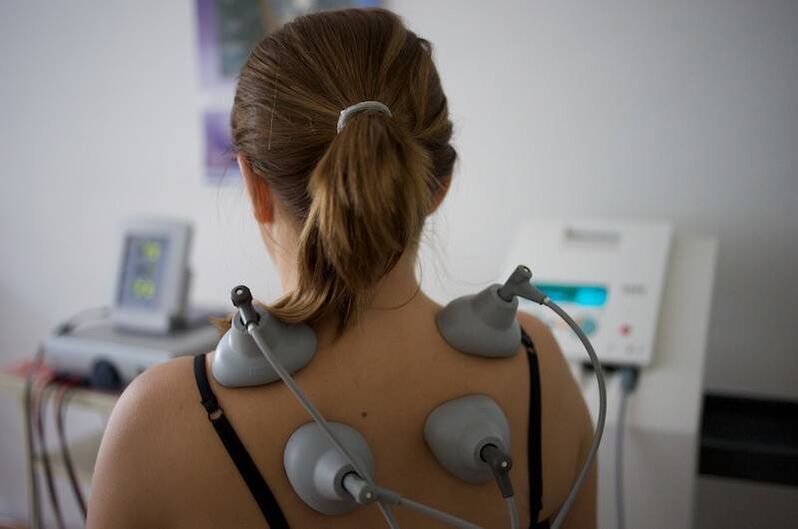
Massage shows efficiency in relieving pain, as a result, lost mobility is restored. Physical impact on the affected area activates blood circulation processes, reduces tone, strengthens muscles. The application of the method minimizes the risk of pathological processes in the future.
During the treatment, different massage methods are used, a lot depends on the clinical picture, the characteristics of the patient's body, the stage of the disease.
Massage has contraindications, which must be taken into account before prescribing the procedure. Caution should be exercised in case of vascular pathologies, contraindications are also considered high blood pressure, injuries, skin inflammation.
Food
Diet plays an important role in osteochondrosis, it must be balanced, it is best to contact a nutritionist. Consumption of salty foods and mineral water should be kept to a minimum. It is recommended to eat 5-6 times a day in small portions, fried, baked, spicy dishes should be replaced by steamed ones. It is recommended to give preference to protein products (legumes, dairy products), chondroitin, sprouted cereals, sesame. Forbidden coffee, alcoholic beverages, strong teas.

Alternative treatment
Alternative treatments are also recommended to be used in combination with traditional methods. A doctor's consultation is required first. Such methods can reduce the severity of symptoms, but not eliminate the cause of the development of the pathological process. As part of folk remedies, ointments, infusions, decoctions, compresses, rubs, baths are widely used. In their production, various herbs, alcohol, oils, honey, etc. are used.
Effective recipes:
- Put a handful of chopped celery in 200 ml of boiling water, insist 5 hours, drink the strained mixture 1 tbsp. l. daily.
- Heat the green leaves of burdock or horseradish in a steam bath, apply on the neck for an hour.
- Mix honey and grated potatoes in equal proportions, use the mixture for dressings.

Therapeutic baths
The effect of therapeutic baths:
- thermal - under the influence of elevated temperature, blood circulation processes are accelerated, intensified, receptor sensitivity increases, enzymes are activated, inflammatory processes are reduced;
- mechanical - under the pressure of water, blood circulation is activated, as a result, the tissues are saturated with oxygen and useful elements;
- chemical - after the addition of salts, minerals, plants, water acquires healing properties, baths have a stimulating effect on the excretory system, resulting in increased resistance to disease.
Baths of conifers, salt, mustard show high efficiency, the duration of the procedure is 20-30 minutes. After the session, it is recommended to lie in a warm bed, because the cold can nullify the overall effect of the therapy. The procedure should be discontinued in the presence of cancer, heart and blood vessel problems.


















